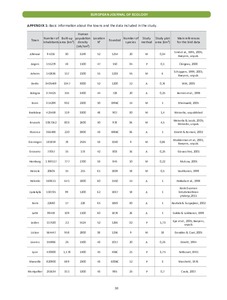Urbanization and species occupancy frequency distribution patterns in core zone areas of European towns
Jukka Jokimäki; Jukka Suhonen; Marja-Liisa Kaisanlahti-Jokimäki
https://urn.fi/URN:NBN:fi-fe2021042716604
Tiivistelmä
More and more of the globe is becoming urbanized. Thus, characterizing the distribution and abundance of species occupying different towns is critically important. The primary aim of this study was to examine the effect of urbanization and latitude on the patterns of species occupancy frequency distribution (SOFD) in urban core zones of European towns (38 towns) along a 3850-km latitudinal gradient. We determined which of the three most common distributional models (unimodal-satellite dominant, bimodal symmetrical, and bimodal asymmetrical) provides the best fit for urban bird communities using the AICc-model selection procedure. Our pooled data exhibited a unimodal-satellite SOFD pattern. This result is inconsistent with the results from previous studies that have been conducted in more natural habitats, where data have mostly exhibited a bimodal SOFD pattern. Large-sized towns exhibited a bimodal symmetric pattern, whereas smaller-sized towns followed a unimodal- -satellite dominated SOFD pattern. The difference in environmental diversity is the most plausible explanation for this observation because habitat diversity of the study plots decreased as urbanization increased. Southern towns exhibited unimodal satellite SOFD patterns, central European towns exhibited bimodal symmetric, and northern towns exhibited bimodal asymmetric SOFD patterns. One explanation for this observation is that urbanization is a more recent phenomenon in the north than in the south. Therefore, more satellite species are found in northern towns than in southern towns. We found that core species in European towns are widely distributed, and their regional population sizes are large. Our results indicated that earlier urbanized species are more common in towns than the species that have urbanized later. We concluded that both the traits of bird species and characteristics of towns modified the SOFD patterns of urban-breeding birds. In the future, it would be interesting to study how the urban history impacts SOFD patterns and if the SOFD patterns of wintering and breeding assemblages are the same.
Kokoelmat
- Rinnakkaistallenteet [27094]
